Genichi Taguchi developed the Taguchi Method as a statistical approach to optimize processes and improve quality. Initially, he created it to enhance manufacturing processes, and it has since been applied to various engineering fields, including biotechnology. The method focuses on reducing variation and improving product quality with fewer experiments, making it widely recognized.
Dr. Genichi Taguchi, a Japanese engineer and statistician, created the method to make design processes more efficient and cost-effective. Industries widely use the method to optimize products and processes.
Table of contents
- What is the Taguchi Method?
- Key Concepts of the Taguchi Method
- Steps Involved in the Taguchi Method
- Taguchi’s Loss Function
- Importance of Robust Design
- Types of Performance Characteristics in Taguchi Method
- Advantages of the Taguchi Method
- Taguchi’s View on Quality
- DOE Process with Taguchi Approach
- Why Use the Taguchi Method?
- Final Words
- Related Articles
What is the Taguchi Method?
The Taguchi Method is a structured approach to improving product and process quality. It aims to identify the optimal conditions for production, reduce variations in the outcome, and minimize costs. By identifying controllable factors that affect a product’s quality, the method helps create processes that are more stable and less sensitive to uncontrollable factors, such as noise.
Definition of Quality
Taguchi defines quality as the consistency of a product’s performance. Minimizing variability and keeping performance close to a target achieves quality.
Key Concepts of the Taguchi Method
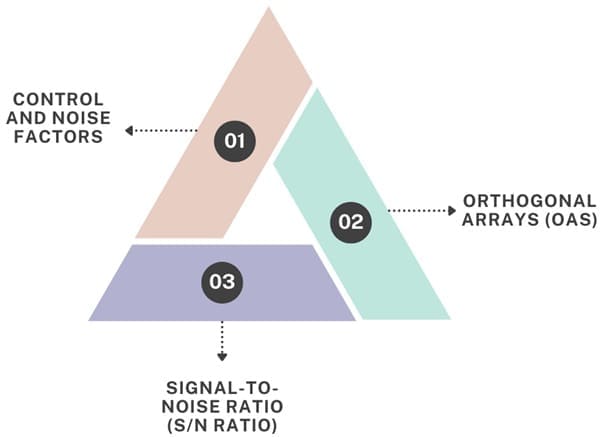
- Control and Noise Factors: Taguchi’s method distinguishes between control factors and noise factors. Control factors are the variables that can be managed during the process, like temperature or material. Noise factors, on the other hand, represent variations that are difficult or impossible to control, such as environmental changes.
- Orthogonal Arrays (OAs): One of the main tools used in the Taguchi Method is the orthogonal array. These arrays help reduce the number of experiments needed by testing multiple factors at once. It allows for a comprehensive analysis with minimal resources.
- Signal-to-Noise Ratio (S/N Ratio): To evaluate the effectiveness of different process conditions, Taguchi introduced the signal-to-noise ratio, which quantifies the variation in a product’s performance. A higher S/N ratio indicates less variation and better quality. There are three main types of performance characteristics:
- Nominal-the-best: The ideal value is close to a target.
- Smaller-the-better: The ideal value is zero or the smallest possible.
- Larger-the-better: The ideal value is as large as possible.
Steps Involved in the Taguchi Method

- Identify the function and side effects: Determine the desired outcome and any potential side effects that may occur.
- Select noise factors: Identify factors that are uncontrollable or difficult to manage.
- Set the objective function: Define what needs to be optimized or achieved.
- Determine control factors: Choose controllable factors and their respective levels.
- Choose an orthogonal array: Select the appropriate array to reduce the number of experiments.
- Conduct experiments: Perform the experiments based on the chosen array.
- Analyze data: Use the results to predict the optimal process conditions.
- Verify results: Test the predicted conditions to ensure they lead to the desired quality improvements.
Taguchi’s Loss Function
Taguchi defines quality differently than traditional quality control systems. He suggests that quality loss occurs whenever a product deviates from its target value. Even if a product meets the specification limits, it can still cause loss if it deviates from the target.
Taguchi’s Loss Function calculates the loss by quantifying the deviation from the target as a form of societal and monetary loss.
Taguchi Method Process
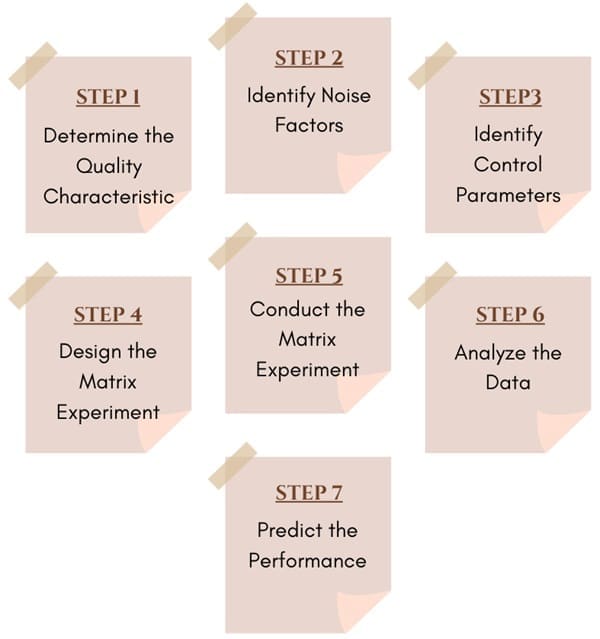
Taguchi’s approach to parameter design follows a systematic process. This process includes the following steps:
- Determine the Quality Characteristic: Identify the key quality characteristic to optimize. This could be any measurable aspect of the product, like strength, weight, or durability.
- Identify Noise Factors: Noise factors are uncontrollable variables that affect product performance. Examples include environmental conditions or wear and tear.
- Identify Control Parameters: These are the parameters that engineers can control, such as design features or manufacturing conditions.
- Design the Matrix Experiment: Use orthogonal arrays to create an experiment matrix, which helps test different combinations of control and noise factors with fewer experiments.
- Conduct the Matrix Experiment: Perform the designed experiments to test the different configurations.
- Analyze the Data: Analyze the results from the experiments to determine the optimal levels for control parameters.
- Predict the Performance: Predict the performance of the product based on the optimal settings of the control parameters.
Taguchi’s Philosophy
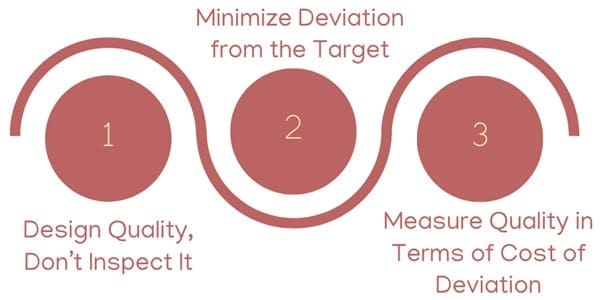
Dr Taguchi’s philosophy for quality improvement focuses on designing quality into products rather than inspecting it afterwards. His philosophy revolves around three main principles:
- Design Quality, Don’t Inspect It: Taguchi emphasized building quality into the product at the design stage. Inspecting or correcting quality later in the process is inefficient.
- Minimize Deviation from the Target: Minimize deviations from the target value to achieve the best quality. The closer the product is to the target value, the better its quality.
- Measure Quality in Terms of Cost of Deviation: Measure the cost of quality based on how much a product deviates from the target. Any deviation causes a loss, which you can quantify to guide improvements.
Importance of Robust Design
Taguchi’s approach to robust design is key in reducing variation and improving quality. He recognized that variations in the production process could arise from uncontrollable factors like weather, machine wear, or raw material differences. His method focuses on minimizing the impact of these factors on product performance.
The goal is to create designs that perform consistently even when these factors change.
Taguchi’s Approach to Design

Taguchi recommended a three-step process to improve product quality:
System Design: This stage focuses on determining the working levels of design factors, such as materials and technology. It involves designing and testing the product based on current knowledge and available technology.
Parameter Design: This step identifies the factor levels that lead to the best product performance while minimizing variation from uncontrollable factors (noise).
Tolerance Design: In this phase, the tolerances of critical factors are tightened to improve product quality. This step may require additional resources, like better materials or more advanced equipment.
Design of Experiments (DOE) in Taguchi Method
Taguchi made DOE more accessible to engineers by simplifying its application. He standardized the process, making it easier to design experiments, analyze data, and improve products.
DOE allows engineers to test multiple variables at once, saving time and resources. By analyzing how different factors impact product performance, engineers can identify and adjust the most influential factors to improve quality.
Taguchi’s Approach to Process Optimization
Taguchi’s method is designed to minimize the variation in the process. He focuses on both the average performance and the variability in product performance. By minimizing variation, Taguchi aims to create processes that consistently meet customer expectations, even in the presence of noise factors.
Controllable vs. Uncontrollable Factors: Taguchi divides factors into two categories:
- Controllable factors: These are design parameters that can be adjusted to improve quality.
- Uncontrollable factors: These are sources of variation that cannot be controlled but can be minimized.
Target Control Factors (TCF): These factors affect the average value of the product’s performance and are adjusted to meet the desired target.
Variability Control Factors (VCF): These factors minimize variability in the product’s performance, even under varying conditions.
Cost Factors: These factors are adjusted based on economic requirements, ensuring that the process remains cost-effective.
Types of Performance Characteristics in Taguchi Method
Nominal-the-Best: For characteristics where the target value is the most desirable. For example, the target frequency of a radio.
Smaller-the-Better: The ideal value is zero. For example, minimizing defects in manufacturing.
Larger-the-Better: The ideal value is as large as possible. For example, maximizing yield in a production process.
Advantages of the Taguchi Method
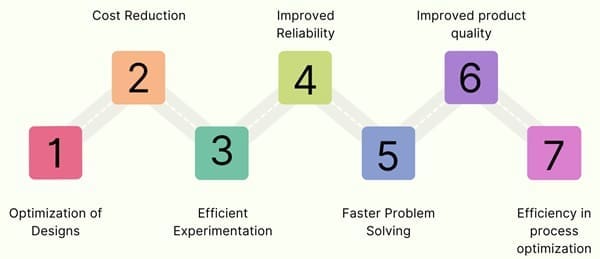
The Taguchi Method offers several benefits:
- Optimization of Designs: Taguchi helps in finding the best design factors to optimize product performance.
- Cost Reduction: By reducing variation and improving quality, businesses can save on costs related to rework, warranty, and scrap.
- Efficient Experimentation: The use of orthogonal arrays reduces the number of tests needed, making experiments more cost-effective.
- Improved Reliability: Taguchi’s approach helps in designing products that perform consistently, even in the presence of uncontrollable factors.
- Faster Problem Solving: The method accelerates problem-solving by identifying the key factors that influence performance.
- Improved product quality: By focusing on reducing deviations from the target, products consistently meet customer expectations.
- Efficiency in process optimization: The method efficiently identifies the most influential factors affecting quality.
Taguchi’s View on Quality
Traditional definitions of quality focus on meeting specifications or customer expectations. However, these definitions don’t explain how to achieve quality or connect it with cost. Taguchi defines quality as the loss a product causes to society once it is shipped.
This includes waste, rework, warranty costs, and customer dissatisfaction. The key to quality is reducing variation from the target value.
When a product’s quality characteristic deviates from the target, it causes a loss. The more variation, the greater the loss. Taguchi’s quadratic loss function shows how variation impacts cost. Quality improvement, therefore, means reducing this variation, which, in turn, reduces cost.
Quality by Design
Taguchi emphasizes designing products and processes that are robust against variations. This means designing products that perform well under various conditions and are not sensitive to uncontrollable factors, known as “noise factors.” There are three key stages in this design process:
- System Design: The product is designed to function under nominal conditions.
- Parameter Design: Here, engineers identify and set the optimal values for controllable parameters.
- Tolerance Design: If needed, tighter tolerances are applied to further reduce variation.
System Design
System design ensures a product functions well under typical conditions. It focuses on understanding the technical aspects of a product and making decisions based on science and engineering knowledge.
Parameter Design
Once the system is in place, parameter design focuses on finding the best values for parameters that can be controlled. The goal is to select parameters that make the product robust against uncontrollable noise factors.
Traditionally, engineers might test each parameter individually to find the best settings, but this process is time-consuming and costly. Taguchi solves this by using orthogonal arrays to study multiple parameters at once. This reduces the number of experiments needed to find an optimal solution.
Orthogonal Arrays in Taguchi’s Method
Orthogonal arrays are a key tool in Taguchi’s method. They allow engineers to test multiple parameters and their interactions efficiently. For instance, an orthogonal array might test four parameters, each at three different levels. This reduces the number of experiments significantly compared to testing all combinations manually.
For example, testing 13 parameters at three levels could involve over 1.5 million experiments. But with Taguchi’s orthogonal arrays, this number can be reduced to just 27 experiments. This makes the process faster and less expensive.
DOE Process with Taguchi Approach
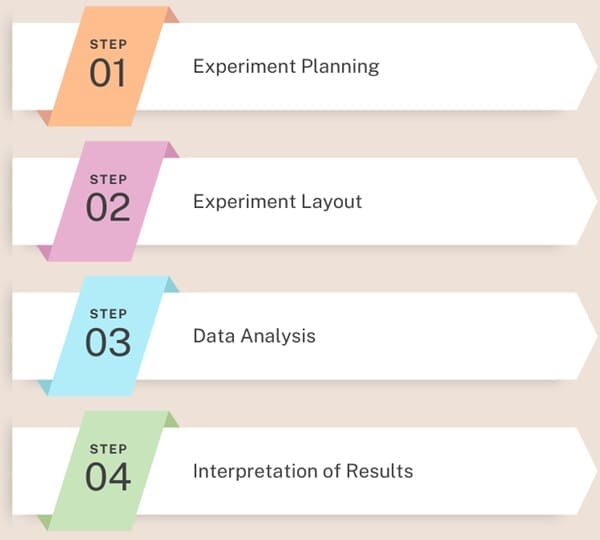
Using Taguchi’s approach in DOE involves careful planning and analysis:
- Experiment Planning: The first step is to clearly define the experimental objectives and factors. Team-based planning ensures consensus on the goals and design.
- Experiment Layout: The layout must be optimized for cost and size. Taguchi provides guidelines for arranging factors and their interactions in a way that minimizes experimental resources.
- Data Analysis: Once data is collected, it is analyzed to determine the factors that most influence performance. Taguchi’s method uses standardized techniques like analysis of variance (ANOVA) to interpret the results.
- Interpretation of Results: The results are interpreted to find the optimum conditions and predict improvements. Taguchi’s loss function helps in quantifying the impact of quality improvements in terms of cost.
Practical Applications of the Taguchi Method
The Taguchi Method is widely applied in various stages of product and process development:
- Product and Process Optimization: Taguchi helps in finding the optimal combination of design factors for better performance.
- Problem Solving: Engineers use the method to solve production problems by identifying the causes of variation and addressing them.
- Manufacturing: The method is used to design robust products that are less sensitive to environmental and process variations.
- Development Testing: In the early stages of design, the method helps simulate how different factors will affect product performance.
Why Use the Taguchi Method?
Cost Savings: By improving product quality and reducing variation, businesses can lower costs associated with defects, scrap, and warranty claims.
Efficiency: The method allows engineers to design experiments that minimize resources and time.
Improved Product Performance: The approach helps create robust products that perform consistently, even under varying conditions.
Final Words
The Taguchi Method is a powerful tool for improving product quality and optimizing designs. By focusing on reducing variation and improving consistency,
Taguchi’s approach helps businesses create robust products that meet customer expectations. His methodology, which includes standardized DOE, robust design strategies, and signal-to-noise analysis, has become a vital tool in industries worldwide.
Through its focus on prevention, rather than inspection, the Taguchi Method fosters a culture of quality that ensures long-term success and cost savings.

About Six Sigma Development Solutions, Inc.
Six Sigma Development Solutions, Inc. offers onsite, public, and virtual Lean Six Sigma certification training. We are an Accredited Training Organization by the IASSC (International Association of Six Sigma Certification). We offer Lean Six Sigma Green Belt, Black Belt, and Yellow Belt, as well as LEAN certifications.
Book a Call and Let us know how we can help meet your training needs.




















The article is good and informative.
A small point may be noted: The title of the article refers to QC, but the opening sentence refers to QA. You know both are different. Pl look into this for any change.
No offence meant from this 80 year old consultant.
R.Venketaramany
Rajaramiyer, Thank you for identifying the error. We have made the change. Thank you for reading our artcles. 80 years old consultant – I bet you have allot of stories.